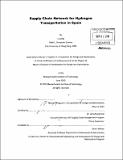Supply chain network for hydrogen transportation in Spain
Author(s)
Liang, Li
DownloadFull printable version (5.619Mb)
Other Contributors
Massachusetts Institute of Technology. Computation for Design and Optimization Program.
Advisor
Jarrod Goentzel.
Terms of use
Metadata
Show full item recordAbstract
Hydrogen fuel is considered one of the major emerging renewable substitutes for fossil fuel. A crucial factor as to whether hydrogen will be successful depends on its cost as a substitute. Recently, there has been a growing interest in investigating the feasibility from a supply chain point of view. This thesis intends to provide a comprehensive study of the feasibility of hydrogen as a transportation fuel from a supply chain point of view. The aim is to discover the most efficient, sustainable, and ultimately most cost-effective strategy to meet future transportation demand scenarios. This includes optimizing costs over production, compression, storage, distribution, and dispensation. Moreover, through the decision support model developed in this thesis, insights regarding strategic approaches for hydrogen supply chain infrastructure development are developed, such as the tradeoff between centralized and distributed production. A case study in Spain is presented to illustrate the supply chain. Different models are proposed to estimate electricity generation capacity, hydrogen production scheme, transportation topology, distribution methods and future demands. Six different scenarios, based on different production scheme, future demand level, are tested. Results from the case study indicate that it is more cost effective to transmit electricity from wind farms to locations close to demand sites to do centralized production. In terms of transportation, liquid gas truck is the preferred mode of transportation from production sites to local demand regions. The model can adapt be extended and adapted to consider other configurations of the supply chain network.
Description
Thesis (S.M.)--Massachusetts Institute of Technology, Computation for Design and Optimization Program, 2010. Cataloged from PDF version of thesis. Includes bibliographical references (p. 77-79).
Date issued
2010Department
Massachusetts Institute of Technology. Computation for Design and Optimization ProgramPublisher
Massachusetts Institute of Technology
Keywords
Computation for Design and Optimization Program.